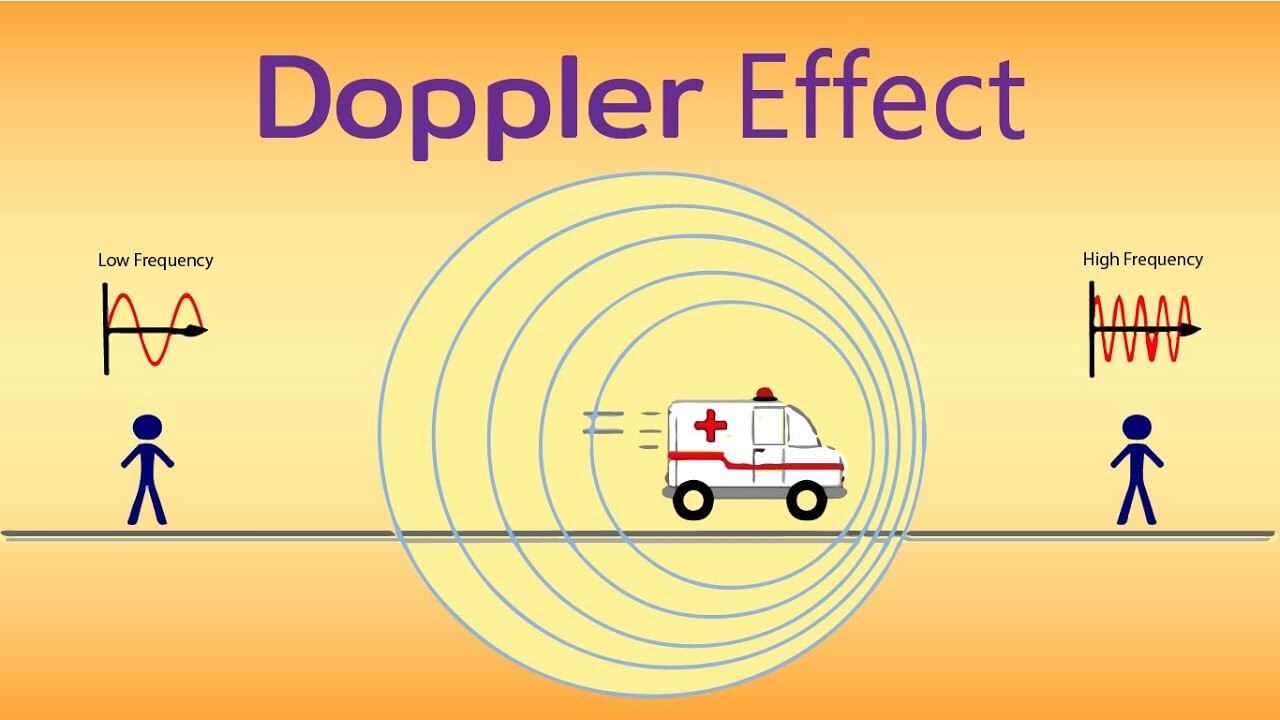Doppler Effect
In this article, we are going to study about Doppler Effect. This is a phenomenon showcased by most waves, including sound and light waves. But generally, we study it with reference to sound and light waves.
 Table of Contents
Table of Contents- What is Doppler Effect?
- Doppler Effect in case of light waves
- Doppler Effect in case of sound waves
- Applications of Doppler effect
What is Doppler Effect?
Doppler Effect is related to the motion-related frequency change of waves.
- As the source of the wave (sound or light wave) moves towards the observer (or the observer moves towards the source), the frequency (or pitch) of the wave seems to increase (called upward shift in frequency), and the observed wavelength decreases. For example, the observed pitch of a fast-moving train that comes towards us appears to be higher than that of the source.
- While, as the source of wave moves away from the observer (or the observer moves away from the source), the frequency (or pitch) of the wave seems to decrease (called downward shift in frequency), and the observed wavelength increases. For example, the observed pitch of a fast-moving train that moves away from us appears to be lower than that of the source.
Doppler Effect was first proposed by Austrian physicist Johann Christian in 1842. He observed it in light waves. Doppler Effect was tested experimentally in 1845 by Ballot in Holland.
As already stated, this effect is a wave phenomenon, and holds true for any wave, be it sound wave, or electromagnetic wave (e.g. light wave).
Doppler Effect in case of light waves
Johann Christian observed that spectral lines of the light coming from certain stars were shifted towards the red or violet end of the spectrum from their normal position by a very small distance. This was because of Doppler Effect.
- Increase in wavelength due to doppler effect is called red shift – herein wavelength in the middle of the visible region of the spectrum moves towards the red end of the spectrum. Red shift of the light implies that the star is receding away from the earth.
- Decrease in wavelength due to doppler effect is called violet or blue shift – herein wavelength in the middle of the visible region of the spectrum moves towards the violet end of the spectrum. Violet or Blue shift of the light implies that the star is approaching towards the earth.
 Note
NoteIt was found that most of the galaxies showcase a red shift in their spectral lines. It proved that most of the galaxies are moving away from us. This supported the idea of Big Bang Theory, and that the universe is expanding (and it’s not static). It dealt a death blow to the Static-State model of the universe.
We know that most waves require a medium for their propagation. However, it’s not the case with electromagnetic waves – they do not require any medium for propagation. That’s why sunlight can reach earth from sun, while travelling through the vacuum of space.
 Doppler Effect in absence of medium
Doppler Effect in absence of mediumIf medium is not present, Doppler shifts are the same irrespective of whether:
- the source moves towards the observer, or
- the observer moves towards the source.
That’s because, in absence of a medium there’s no distinction between the two situations.
Doppler Effect in case of sound waves
In case of sound waves, as the sound source moves towards the observer, the pitch/frequency of the observed sound increases.
Similarly, as the sound source moves away from the observer, the pitch/frequency of the observed sound decreases.
Applications of Doppler effect
- As already stated, astrophysicists use Doppler effect to measure the velocities and direction of movement of distant astronomical objects, such as stars and galaxies.
- We can find the speed of an automobile by measuring Doppler shift in the electromagnetic wave reflected from an automobile. So, it is used by police to check over-speeding of vehicles. To do so, sound wave or electromagnetic wave of known frequency is sent towards the desired moving object. Some part of the wave is reflected from the object and the frequency of the reflected wave is detected by the monitoring station.
- It is used by air force and civil aviation to guide aircrafts and detect enemy aircrafts.
- Doppler also find its usage in medical science, e.g. in sonography and echocardiogram. In sonography, ulltrasonic waves are used – they enter the body and are reflected back. This helps the doctors detect the motion of blood, internal organs, pulsation of the heart of the foetus, etc. In echocardiogram we study the heart in a similar manner – here we get to study the pulsation of heart valves, and even get to see a picture of the heart.

